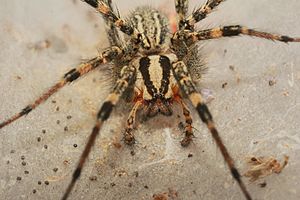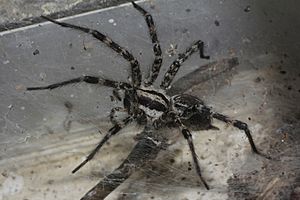Desert grass spider facts for kids
Quick facts for kids Desert grass spider |
|
|---|---|
 |
|
| Scientific classification | |
| Genus: |
Agelenopsis
|
| Species: |
aperta
|
The Agelenopsis aperta, also known as the desert grass spider or funnel-web spider, is a type of spider. It belongs to the family Agelenidae and the group Agelenopsis. These spiders live in dry areas across the southern United States and into northwestern Mexico.
Their bodies are about 13-18 mm long. They have long legs that help them run fast to catch their food. Desert grass spiders can handle very cold temperatures. They build special funnel-shaped webs in cracks or bushes. They wait inside the tube part of the web for prey. When an insect lands on the web, the spider runs out quickly to grab it. They often hunt for their food at night.
Desert grass spiders are known for protecting their space. They will fight other spiders that try to enter their territory. Most desert grass spiders mate with only one partner. The male spider does a special dance to attract the female. He sways his body and releases special chemicals called pheromones. These chemicals make the female spider go into a sleepy state. After she wakes up, they mate. Desert grass spiders inject venom into their prey to paralyze them quickly. However, their bites are not considered harmful to humans. Scientists have studied a substance in their venom called agatoxin. This substance can block certain channels in the body.
Contents
About the Desert Grass Spider
Desert grass spiders are gray, brown, and black. Their cephalothorax (the front part of a spider's body) is tan or gray. It has two brown stripes running along it. The abdomen (the back, larger part of the body) is tan with two black stripes. This striped look is common for spiders that build funnel webs.
Their legs are quite long. This helps them run very fast to catch prey on their webs. The cephalothorax and abdomen together are usually 13–18 mm long. Female spiders are bigger than males, which is normal for grass spiders. Desert grass spiders have clear spinnerets. These are the organs that make silk for their webs. Their spinnerets are long and stick out from the end of their abdomen. Desert grass spiders have eight eyes. They are arranged in two rows that form a curve.
Where They Live
As their name suggests, desert grass spiders live in dry places. You can find them in the southwestern United States. This includes areas from southern California to Texas. They also live in northwestern Mexico.
They can live in many different places. These include grasslands, areas with lava rocks, and open rangelands. Sometimes, they are even found inside people's homes or other buildings. They build their webs in quiet corners of these places.
Surviving Cold Weather
A. aperta spiders can handle very low temperatures. Studies have shown they are not hurt by cold temperatures close to their bodies. However, they do not "cold harden". This means they don't develop special traits to survive extreme cold. Instead, they likely move to safer, warmer spots in their habitat. They do this during very cold times to stay safe.
Their Funnel Web
A. aperta are known as funnel weavers. They build webs that look like a funnel. Their webs have a flat sheet connected to a deep tube. This tube is the "funnel." The spider waits inside the tube. When it feels movement on the flat part of its web, it rushes out to catch its prey. If the web gets damaged, these spiders can also escape through an opening at the bottom of the funnel.
Their webs are made of non-sticky silk. This is because of their unique shape and how fast they catch prey. Their webs are often built close to the ground. This helps them catch more insects that might fall onto them. They often build webs in cracks where the funnel fits. This could be between rocks or on top of a bush. Where they build their webs depends on the environment. In grasslands, they build them in tall grass. In lava beds, they are usually near shrubs. Spiders that find the best spots for their webs grow the largest. They are also considered the most successful.
Protecting Their Space
The desert grass spider protects its territory. Their webs are usually spread out evenly. Also, they often show aggressive behavior. These are signs of territoriality. Studies have shown that spiders that fight more often have larger territories.
Scientists have studied how A. aperta spiders fight over their territory. Biologist Susan Riechert found that these spiders often fight to protect their space. She studied if these fights were worth the risks. Risks include getting hurt, being eaten by predators, or losing time. For spiders trying to take over a territory, the risks were higher. She concluded that the energy used in these fights was small. It was worth it for the spider to gain or keep its territory.
What They Eat
These spiders eat insects that land on their webs. Common prey include insects found in grass, like grasshoppers and aphids. They also eat other spiders. Desert grass spiders are most active at night when they hunt for food. However, they might come out during the day if prey steps on their web.
A. aperta can tell the difference between good prey and less good prey. "Good" means how much energy they get and how risky it is to catch. But they don't always attack the "better" prey more often. If there wasn't much food available, spiders tried to catch more of the prey they found. This was especially true if there was also a low risk of being eaten by a predator.
Who Eats Them
Birds are the main predators of A. aperta. Spiders living in grasslands are not often eaten by predators. But spiders in woodland areas face more danger. Research shows that a spider's anti-predator behavior is linked to hunting. Hunting puts them at higher risk. So, they need to be more alert for predators.
Mating and Babies
Most A. aperta spiders mate with only one partner. This often happens when it's hard for males to travel to other mates. It also happens if the female is less likely to mate again after the first time. Some spiders, about 10%, do mate with more than one female. Males are much more likely to mate with many females than females are to mate with many males.
When males fight over a female, the larger male usually wins. A larger size shows that he might have successful offspring. For females, success is about winning fights over food.
Courtship Dance
For the courtship ritual, the male spider comes to the female's web. He sways his abdomen from side to side. Then he stops for a bit, and starts swaying again. He repeats this many times. The male also taps the web with his legs. It seems that the faster the male sways, the more likely he is to be successful.
The female spider enters a sleepy state. This means she loses control of her body and is not fully aware. Experiments show that this sleepy state is caused by pheromones. These are chemicals released by the male into the air. These chemicals work within about 3 cm. The male's movements during his dance might also help send these chemicals to the female. Some males mate while the female is in this sleepy state. But most wait and continue their dance. The female chooses her mate based on these chemical signals and the male's dance moves.
Spiderling Behavior
A. aperta spiderlings are known for being competitive and aggressive. At first, all the baby spiders share one large web. Later, they spread out and build their own webs close to each other. Since many siblings are close by, most of them compete for food.
Their Bite
When A. aperta bites insects, it causes them to become paralyzed very quickly. The venom works in less than a second. They bite their prey on the flat part of the web. Then, they carry the prey down into the funnel.
Bites from desert grass spiders are usually harmless to humans. They are not considered dangerous enough to need medical attention. However, there have been a few cases in Southern California where people had symptoms. It's hard to know if these cases were truly from desert grass spiders. They might have been confused with other similar-looking spiders. Symptoms reported included headache, weakness, confusion, pale skin, and tiredness. One case involved a 9-year-old boy bitten on the neck. His smaller size and the bite location might have made symptoms worse. These symptoms are similar to those seen from the hobo spider. The hobo spider is a close relative and has been linked to more serious bites.
Agatoxin in Venom
Spiders store venom in glands near their fangs. They squeeze muscles around these glands to release the venom. Scientists have studied omega-agatoxin IVA and IVB a lot. These are found in the desert grass spider's venom. This agatoxin specifically blocks calcium channels in humans. This means less calcium can flow through them. Less calcium leads to fewer neurotransmitters in the synaptic cleft. This means signals in the body can't work as strongly. Agatoxins are named after A. aperta. But they are found in the venom of many different types of spiders.
Images for kids
See also
 In Spanish: Agelenopsis aperta para niños
In Spanish: Agelenopsis aperta para niños



